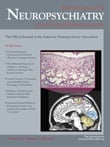Case Report
An 83-year-old man with progressive supranuclear palsy was being treated with Sinemet (carbidopa/ L -dopa 25 mg/100 mg, 125 mg t.i.d.) for 8 months. Due to nausea, Sinemet was replaced by low dose madopar ( L -dopa/benserazid 100 mg/25 mg, 62.5 mg t.i.d.) and bromocriptine (2.5 mg t.i.d.). For the following 2 months, pathological hypersexuality (sexually suggestive remarks, touching, kissing, disrobing, exposing genitalia, facial flushing, penile erection, public masturbation) slowly developed. At this point, his serum testosterone level was normal (2.3 ng/ml), whereas serum prolactin level was suppressed to 1.3 ng/ml.
His pathological hypersexuality completely disappeared 2 weeks after discontinuation of bromocriptine. After 4 weeks, pramipexole (0.125 mg b.i.d.), another dopamine receptor agonist, was added instead of bromocriptine since his motor performance deteriorated. After 1 week of pramipexole, all the hypersexual symptoms reemerged. At this point, his serum prolactin level was 2.2 ng/ml.
His pathological hypersexuality completely disappeared again just by discontinuing pramipexole. Then we titrated madopar up to 125 mg t.i.d. instead of adding other dopamine receptor agonist. After 3 weeks, his motor performance improved with partial reemergence of hypersexual symptoms (penile erection, facial flushing, sexually suggestive remarks, touching). However, the severity of the reemerged symptoms was much more tolerable than those induced by dopamine receptor agonist. At this point, his serum prolactin level was not suppressed (13.3 ng/ml).
Comments
This case confirmed an earlier observation
1 through rechallenging two different kinds of dopamine receptor agonists alternatively in a single patient, and illustrated several characteristics of dopamine replacement therapy-induced pathological hypersexuality.
First, dopamine receptor agonists may be more likely to induce pathological hypersexuality than L -dopa since pathological hypersexuality induced by combination therapy of either bromocriptine or pramipexole with L -dopa was much more severe than that induced by L -dopa monotherapy.
Second, dopamine replacement therapy-induced pathological hypersexuality may be mediated by D2 receptor agonism since pramipexole has no affinity for D1 receptor classes.
2Third, dopamine receptor agonist-induced pathological hypersexuality may perhaps be mediated by the excessive stimulation of the D3 receptor subclass since pramipexole binds preferentially to D3 receptors with high affinity.
2Fourth, the difference in the risk of pathological hypersexuality between dopamine receptor agonists and
L -dopa may be attributed to their differential suppression of prolactin secretion since serum prolactin was abruptly suppressed when bromocriptine or pramipexole was added to
L -dopa. Inhibitory effect of dopamine receptor agonists on prolactin secretion was suggested as a main pathogenic mechanism of hypersexuality.
3
